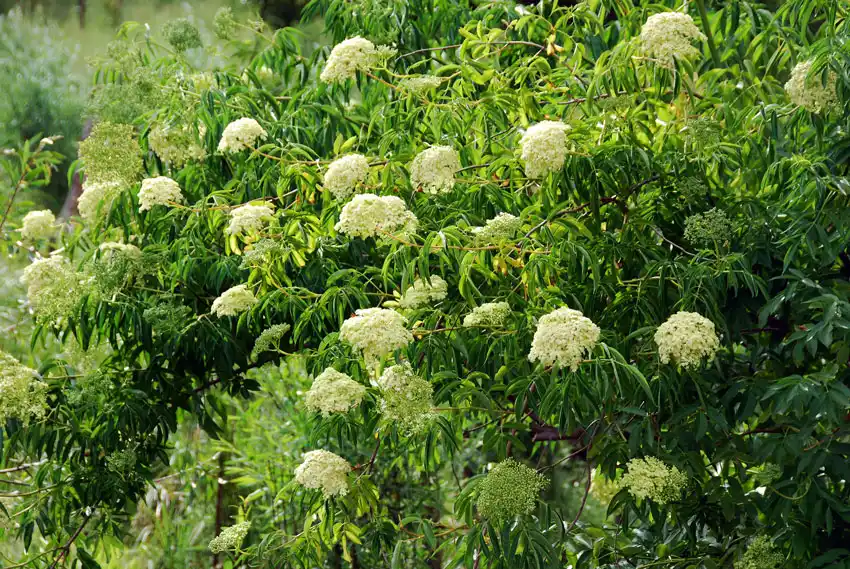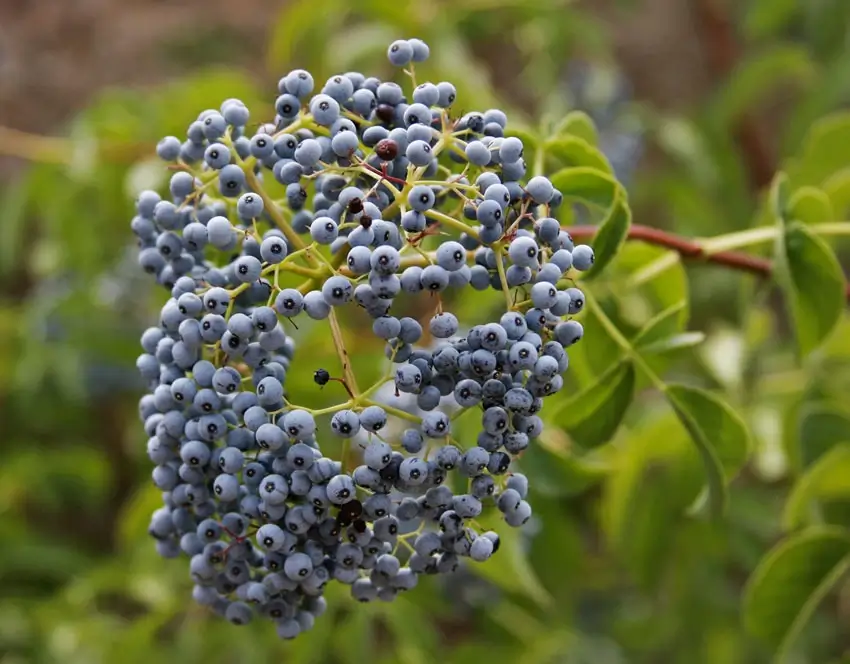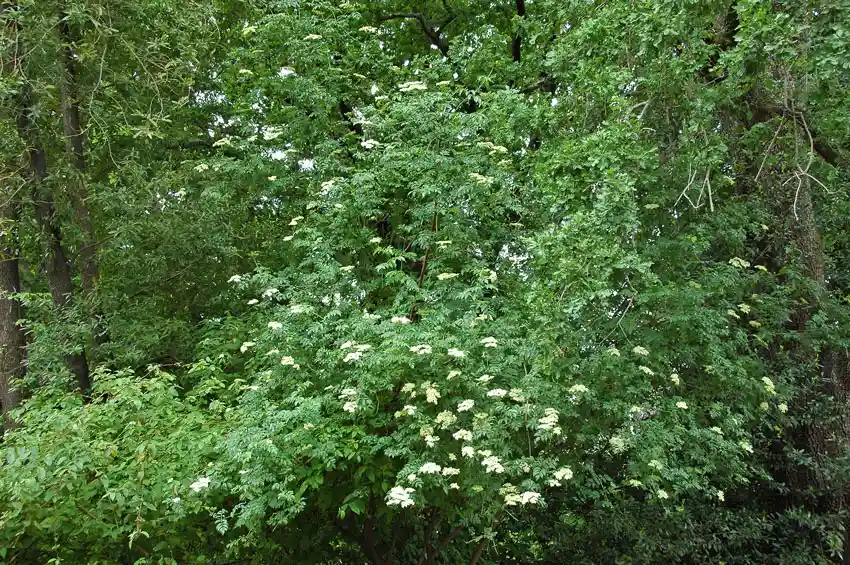Elderberries are fast-growing when planted in mostly full sun exposure and watered regularly; a one-gallon-sized plant can become a six to ten-foot, multi-trunked shrub within a year! They are a great choice for closely planted hedgerows combining small trees, shrubs, vines, grasses, and spreading perennials.
Elderberry is a terrific plant for the habitat garden! This one plant provides so many resources; flowers in early summer are a magnet for pollinators and other beneficial insects; berries in late summer through the fall provide for birds and small mammals; and an established shrub provides cover and nesting sites for songbirds.
Many small, and mildly fragrant white flowers are held in umbels and begin to bloom in early summer, followed by berries in late summer and early fall. The elderberries are black (nigra) with a bluish caste (caerulea). As the berries start to develop they acquire a whitish film, but as they fully ripen this film disappears and the fully ripened berries are a deep bluish-black. The berries are better eaten raw in small quantities only; harvest larger quantities when you are planning to cook them for one of the delicious, and very healthy, products that can be made with these berries. Elderberries are rich with antioxidant, antiviral, and antibacterial properties, and using a tonic made from the berries really strengthens the immune system.
In our demo gardens at Home Ground, we have included Elderberries in a dense planting with plum trees, guavas, pomegranates, native roses, lemonade berries, sugar bush, and sunflowers, plus a variety of grasses and perennials for pollinators. I call this a ‘fedgerow’; my term for a hedgerow full of food plants for humans (and we all know that plenty of animals will also relish the fruits provided).
A young Elderberry can also be trained into a single-trunked tree, which reveals a nice form and the handsome bark of a larger, mature trunk. It can be underplanted with grasses, Douglas Iris, and Yerba Buena: I like to make sure the plants we have planted under our trees are not damaged when we’re harvesting the fruits. If you don’t plan to harvest fruits then a nice companion plant is Hummingbird Sage (Salvia spathacea), which will spread, creating a drift that blooms from early summer to the fall.
Since Elderberries are native to the whole Northern Hemisphere they have a long history of usage in many different human cultures. The name itself (‘elder’ earlier, or older, than others’) implies this. The word ‘elder’ stems from the Old English word ‘ellaern’ which eventually translated to the feminine name Ellen; in old European cultures, the woman named Ellen was the person who was the ‘fire keeper’ for the community. Elderberry stems make good fire drill sticks, and once that spark has taken in soft tinder it could be kept alive by ‘Ellen’.
Elderberries are deciduous shrubs that produce their flowers and fruits on newer wood, so a good practice is to ‘coppice’ the shrub in the dormant season. Coppicing is a form of pruning in which all (or only selected) older stems are cut down to about 12 or 18 inches from ground level. This method is good ‘renewing’ practice for a number of cultivated cane fruits; and also a practice the Native Peoples used to create the nice, long straight shoots they needed for tools and the beautiful basketry that the California tribes are particularly noted for. They would regularly coppice the ‘Squaw Bush’ (Rhus trilobata), Redbud (Cercis occidentalis), and Elderberries. The Native Peoples used the stems as fire drills, and also to make flutes and clapper sticks. The new growth after coppicing created longer spaces between nodes, making them particularly good for the musical instruments.
Home Ground founder Charlotte Torgovitsky notes that:
“Elderberries have always been important to me and my family; I am from Denmark, and each summer my grandmother and I always collected the flowers for a sun-tea, or to make delicious flower ‘fritters’. In the fall I collect the berries for my year-round tonic, or to make a liqueur or meade. I also make a jelly from some of the berries, and dry others for tea.
If you plan to make various products with the berries be sure to grow your own! I used to also look for sources in the wild, and when my Dad would visit me we always hiked one trail which had a really nice shrub to pick a few berries from. Now almost 30 years later, we wouldn’t even be able to reach any of them since that shrub has grown to the size of a coast live oak; the biggest Elderberry I have ever seen!”



